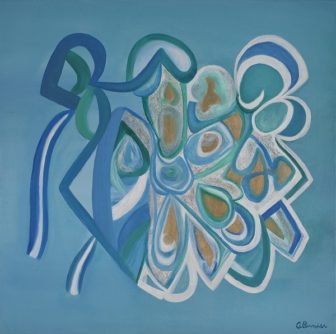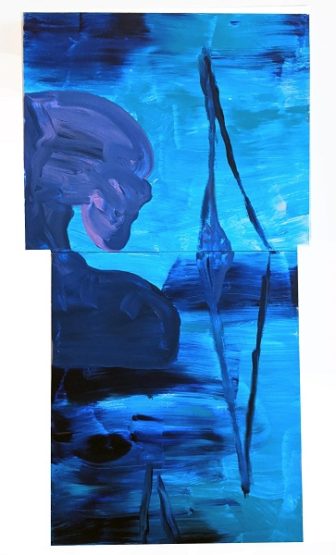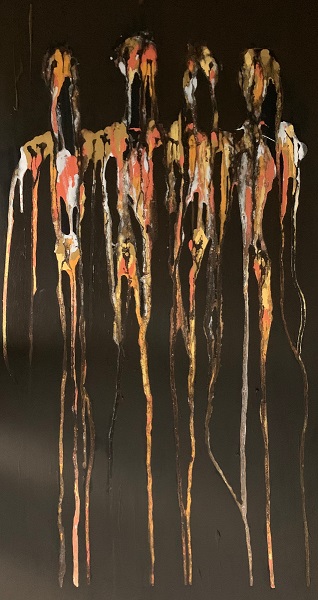
“Mesmerizing,” by Alberte Bernier, is part of “And in That Place Where Flower and Flame Meet We Grow” at YES Gallery in Hoboken.
The Barsky Gallery is currently open by appointment only. The PROTO Gallery, another linchpin of Hoboken art, is temporarily closed. The Hob’art collective space was great while it lasted, but it doesn’t look like it’s coming back.
The Mile Square City remains one of the great arts towns in the Garden State, but it hasn’t been easy to catch a show there lately. Hoboken needed another gallery — or at least a new clubhouse for appreciators of regional creativity.
They’ve gotten one. The YES Gallery, which opened at 408 Sixth St. this month, is a West Side art space with the ramshackle soul of ’80s Washington Street. It’s the creation of actor Jannie Wolff, who has curated art shows in Hoboken and New York before, and worked with local notables including confrontational color specialist Anthony E. Boone. “And in That Place Where Flower and Flame Meet We Grow,” the inaugural YES Gallery exhibition, showcases the work of an 11-deep crew of attention-grabbers, including the Chilean-American sculptor and mischief-maker Hector Miranda, the riddle-weaver Sandra DeSando, the tirelessly energetic and imaginative painter and illustrator Guillermo Bublik, and visual storyteller Caridad Sierra Kennedy, whose dream-drenched canvases often allude to Latin American history and world literature.
One of the most effective artists on display is Wolff herself. Without exhibiting any pieces, she makes her aesthetic manifest. With the help of Stephen Cimini, who assisted in the hanging of the show, she has transformed an old-school tin-ceilinged Hoboken storefront into a puzzle-box: part treasure attic, part museum side room, part jewelry store minus the jewelry.
Wolff and Cimini have tucked art everywhere, appointing the room with paintings, sketches and sculptures. There are canvases on every wall, pictures leading up the staircase to an art-stuffed loft, drawings locked under glass-paneled cases, little works tucked in cubbyholes under the steps, designer sneakers by DERTY in a makeshift shoe rack, and a wooden table of clockwork-gear assemblies by the mad mechanic Linus Coraggio, whose welded assemblies of metal parts feel simultaneously erotic, “Road Warrior” post-apocalyptic, and insect-like.
That none of this feels cluttered is testament to Wolff’s sense of grace and her determination to maximize the space she’s allotted herself. She gives each piece just enough room to breathe and not a millimeter more.

Sandra DeSando’s “All Along the Watchtower.”
Coraggio is associated with The Rivington School and the massive, near-anarchic assembly of disused scrap metal and machine parts that once rose over a vacant lot on a Lower East Side corner. Rivington School artists located the harmony in the haphazard and amplified the post-industrial song of steel on steel. It foreshadowed much of the work that has been done in Northern New Jersey over the past three decades, including the handmade aesthetic of Hoboken before the condominium boom.
Corragio’s inclusion in “And in That Place Where Flower and Flame Meet We Grow” is one of many connections between YES Gallery and Hudson County art as it once was (and still is, if you look carefully enough at the cracks between the new constructions). Another is DeSando, who has been making subtly provocative art in Jersey City for decades. (She was part of the freewheeling Art Center at 111 First Street, the demolished Jersey City studio complex that continues to cast a long shadow over public culture on the less celebrated side of the Hudson.) Recently, she has allowed her elemental, suggestive paintings to jump between panels: “All Along the Watchtower,” a two-piece work, feels like a distorted mirror, a trick of the eye, and an examination of the play of light on water.
Even the artists in the show who appear to prioritize color and design over storytelling turn out, upon closer inspection, to have a healthy relationship to tradition and history. The front wall of YES Gallery is dominated by talkative canvases by Dominican-American painter Danilo Peguero, whose paintings of infernal machines, keening socialites, animal heads, jagged moons and musical instruments feel like two-dimensional spins on Corragio’s not-dissimilar obsessions. Peguero makes his debt to his antecedents clear: visual references to Picasso, Velázquez, Toulouse-Lautrec and others are apparent in his paintings.

Guillermo Bublik’s “Travelers 6.”
Other artists in the show are deeply associated with Hudson County. Alberte Bernier is a New Yorker, but her gentle, quietly aching plays of color and shape have been exhibited at the old Hob’art Gallery and Drawing Rooms, one of the oldest and most respected arts organizations in Jersey City. Bublik, a former Chicagoan and a fast learner, is a newcomer to the county, but he’s become a pandemic-era local favorite; his spooky “Travelers 6,” a depiction of elongated, rust-colored apparitions on a black background, has the corrosive quality common to those working in the Hudson County post-industrial style. Annette Werndl’s vibrant color fields are cheerier, but they still speak of collisions and interventions. She’ll have the run of Gallerie Hudson (197 Newark Ave.), an art space located at one of the busiest intersections in Jersey City, where her solo show will open on Sept. 9.
Then there is Caridad Sierra Kennedy. Her paintings are smaller than those of her YES Gallery neighbors, and they don’t shout as loudly. But let them sneak up on you and, quietly, they’ll steal the show. “In Search of Tomorrow” depicts a ladder stretching toward a crescent moon crowded by arc-like sweeps of yellow and brown. The stepladder and moon reoccur in “La Escalera de Jacob,” a stark landscape in which distant fortifications and ripples on placid water melt together into blue-black night air. The sense of melancholy is broken by the reflection of the ladder on the water — an unearthly slash of light — and the shimmering moon in a hazy sky.
In the Book of Genesis, Jacob’s Ladder is a conduit between heaven and earth, and proof to the patriarchs that the celestial realm isn’t as far away as it may sometimes seem. Hoboken, too, feels like an awfully terrestrial place these days — settled, brick-bound and thoroughly developed, and given over to commerce. But those who experienced the Mile Square in the heyday of Maxwell’s remember its mystery well. YES Gallery is a reminder that that spirit is still with us.
For more on YES Gallery, visit janniesusan.blogspot.com.
Blessings,
Jannie Susan














